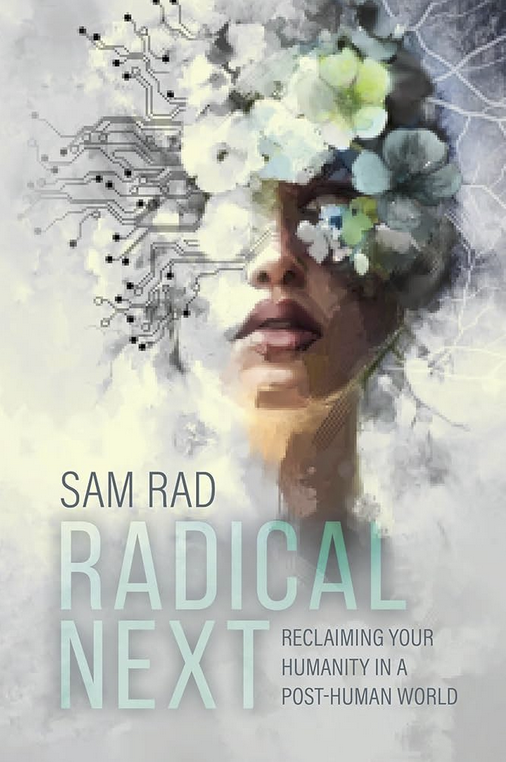Sam Rad and the Art of Freefall
By Smartacus facilitated by Dan Forbush
The air inside the chapel of Universal Preservation Hall held a quiet gravity—a space designed for reflection now hosting a conversation about societal freefall. The setting itself, historic and enduring, offered a silent counterpoint to the dizzying subject at hand: the Age of Acceleration, a time when all things solid seem to melt into data streams, synthetic realities, and exponential change.
Stepping into this atmosphere on Sunday afternoon was Samantha Radocchia, who has trademarked the name Sam Rad—a futurist, anthropologist, and entrepreneur with the calm intensity of someone who has literally fallen from the sky. She has just published the highly acclaimed bestseller, Radical Next: Reclaiming Your Humanity in a Post-Human World.
Moderator Dan Forbush began by illustrating the topic itself, noting that much of the introduction he had just delivered was written from sources uploaded to NotebookLM, a screen shot of which you’ll find below.
“You can see the sources in the left-hand column,” said Forbush, referring to this handout, which you may click below to enlarge:
“You can see the sources in the left-hand column,” he continued. “NotebookLM aggregates all of this content into a single neural net that regenerate it in any way we wish.”
Rad smiled and nodded. “I’m impressed with its obsession with mortality,” she said, “perhaps because it’s something AI can’t quite comprehend.”
Her remark framed the conversation that followed—one balancing wonder and warning, humanity and machine. At its center was a single, terrifying story: the skydiving accident that nearly killed her and, in doing so, taught her how to live.
The Lesson of the Fall
On her third solo jump at 13,000 feet, Rad’s body did what any human body would do: it panicked. Instinct told her to brace, to reach back toward the plane. That reflex sent her spinning out of control, tangled in her own parachute. She survived only by doing the opposite of instinct—by letting go.
Sam Rad at the Saratoga Book Festival
“What works on the ground,” she told the audience, “is the opposite of what works in the sky.”
That revelation—relax, release, surrender—became the foundation of her worldview. Humanity, she argued, has also left the ground. We are in midair now, a collective freefall where our old instincts, systems, and institutions no longer apply. The skill required for survival is adaptability: the courage to unlearn.
The Age of Acceleration
Rad described the Age of Acceleration not as an age of AI alone, but of technological convergence. Artificial intelligence, quantum computing, biotechnology, extended reality, and blockchain are advancing together, amplifying each other’s velocity. The result, she said, is an exponential curve of change that has outpaced the industrial-era systems designed to contain it.
“Our social operating system is outdated,” she observed. “It’s running 21st-century code on 19th-century hardware.”
This mismatch, she explained, fuels a crisis of disconnection. Modern society privileges logic, hierarchy, and control—what she called the “left-brain lens.” The imbalance manifests as polarization, fear, and division. Foreign powers exploit it through misinformation campaigns, while private investors feed it by funding military technologies born of anxiety rather than imagination.
Amid that confusion arises a new condition she calls AI psychosis—not clinical illness, but the erosion of shared reality.
In 2020, Rad created a deepfake clone of herself—complete with her likeness, voice, and digitized thoughts—and found herself haunted by the question, What is real? That question now shadows us all. Is the influencer human or algorithmic? Is the voice on the phone authentic or synthesized? The danger, she said, is not madness but drift—a society losing its collective anchor to truth.
Radical Reconnection
Against that drift, Rad offered a remedy she calls Radical Reconnection—the conscious rebuilding of coherence on three levels:
With Self. True reconnection begins inward, reclaiming authenticity from algorithmic influence. Each person, she said, carries an “energetic signature,” a distinct vibration that must be honored. Humanity is more than cognition—it’s physical, emotional, and intuitive intelligence. To resist manipulation, one must have the courage to be “unapologetically you,” even if that looks unconventional.
With Each Other. Technology promised connection and delivered distraction. The cure, Rad said, is presence: “Get back in rooms together.” She urged listeners to revive in-person gatherings, community clubs, and meaningful dialogue to counter the isolating spiral of online debate.
With Society. Rather than tinkering with obsolete institutions, Rad called for imagining new ones. We must move, she said, from unconscious avatars to conscious players—and ultimately to architects of the game. Instead of a “flat chessboard” of rigid hierarchies, she envisions a living, multidimensional system guided by cooperation and aligned with the superintelligence of nature. Decentralized models, such as early blockchain communities, suggest what that might look like: systems that reward collective good over private gain.
The Architect’s Choice
As the conversation neared its close, Rad’s tone turned from urgency to acceptance. She admitted that she thinks about the destructive potential of AI “ninety-nine percent of the time,” but chooses not to live in fear. The antidote, she said, is adaptability—the capacity to find calm within chaos.
Here she invoked the Japanese concept of wabi-sabi: the beauty of imperfection. She described a crumbling building sprouting bright green plants, cracked stones radiating quiet grace. The pursuit of perfection, she warned, is the surest path to sterility. “Destabilization,” she said, “is part of the cycle.” The decay we fear may be the soil of new creation.
Her message distilled into a single invitation: embrace discomfort. The future, she reminded the audience, is not a destination but a frequency—something we tune ourselves to through attention, courage, and community.
“The only tool we need,” she said finally, “is the human body.”
That body, she explained, is the bridge between logic and intuition, between fear and surrender. To move through the turbulence of this age, we must remember what she learned while tumbling through the open sky: relax, breathe, and trust the fall.


